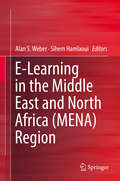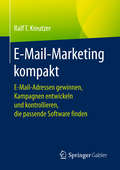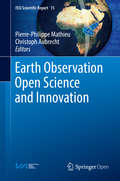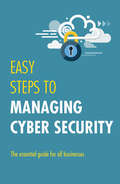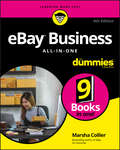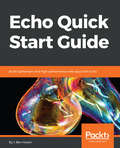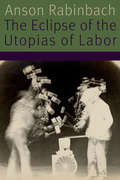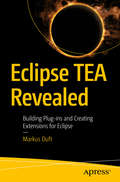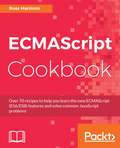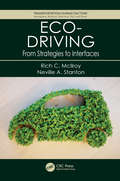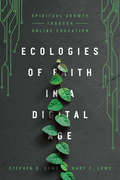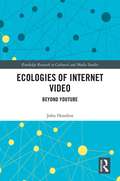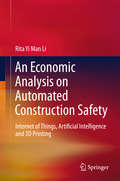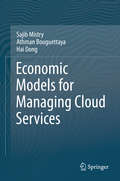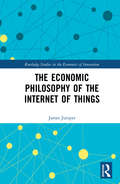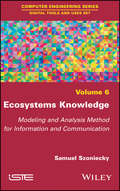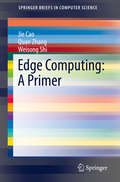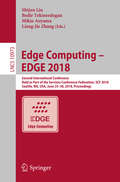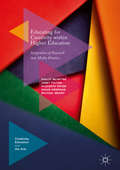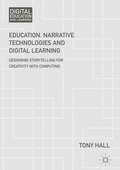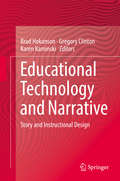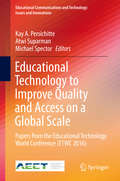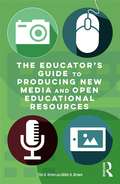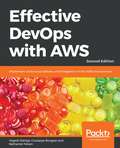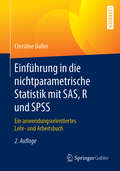- Table View
- List View
E-Learning in the Middle East and North Africa (MENA) Region
by Alan S. Weber Sihem HamlaouiIn the last decade, due to factors of ICT infrastructural and broadband maturation, rising levels of educational attainment and computer literacy, and diversification strategies, e-learning has exploded in the Middle East and North Africa (MENA) region. However, significant barriers remain in the region’s e-learning development: lack of research on outcomes and effectiveness, paucity of Arabic language learning objects, monopolies and high cost of telecommunications, cultural taboos, accreditation, censorship, and teacher training.This unique volume is the first comprehensive effort to describe the history, development, and current state of e-learning in each of the 20 MENA countries from Algeria to Yemen. Each entry is expertly written by a specialist who is acutely familiar with the state of e-learning in their respective country, and concludes with a bibliography of key reports, peer-reviewed books and articles, and web resources.E-Learning in the Middle East and North Africa (MENA) proves itself as a vital compendium for a wide readership that includes academics and students, transnational program directors, international education experts, MENA government departments, commercial vendors and investors, and ICT development and regulatory agencies involved in e-learning in the Middle East.
E-Mail-Marketing kompakt: E-mail-adressen Gewinnen, Kampagnen Entwickeln Und Kontrollieren, Die Passende Software Finden
by Ralf T. KreutzerDieses Buch zeigt, dass E-Mail-Marketing für die Unternehmenskommunikation unverzichtbar ist und bleibt. Es gibt über fünf Milliarden E-Mail-Accounts, aber "nur" zwei Milliarden Facebook-Nutzer! Schon allein durch diese Zahlen wird die Relevanz des E-Mail-Marketings deutlich. Durch E-Mail-Marketing kann und darf unmittelbar verkauft werden. Und Erfolge lassen sich leicht feststellen. Aber wie sollte das E-Mail-Marketing heute ausgestaltet werden? Welche Erfolgsfaktoren sind zu berücksichtigen? Wie sind E-Mails und E-Newsletter zu gestalten, um eine möglichst hohe Wirkung zu entfalten? Und anhand welcher KPIs kann der Erfolg gemessen werden? In diesem Werk werden alle zentralen Fragen zum E-Mail-Marketing kompetent beantwortet.
Earth Observation Open Science and Innovation (ISSI Scientific Report Series #15)
by Pierre-Philippe Mathieu Christoph AubrechtThis book is published open access under a CC BY 4. 0 license. Over the past decades, rapid developments in digital and sensing technologies, such as the Cloud, Web and Internet of Things, have dramatically changed the way we live and work. The digital transformation is revolutionizing our ability to monitor our planet and transforming the way we access, process and exploit Earth Observation data from satellites. This book reviews these megatrends and their implications for the Earth Observation community as well as the wider data economy. It provides insight into new paradigms of Open Science and Innovation applied to space data, which are characterized by openness, access to large volume of complex data, wide availability of new community tools, new techniques for big data analytics such as Artificial Intelligence, unprecedented level of computing power, and new types of collaboration among researchers, innovators, entrepreneurs and citizen scientists. In addition, this book aims to provide readers with some reflections on the future of Earth Observation, highlighting through a series of use cases not just the new opportunities created by the New Space revolution, but also the new challenges that must be addressed in order to make the most of the large volume of complex and diverse data delivered by the new generation of satellites.
Easy Steps to Managing Cybersecurity
by Jonathan ReuvidProviding an insight to the extent and scale a potential damage could cause when there is a breech in cyber security, this guide includes case studies and advice from leading industry professionals, giving you the necessary strategies and resources to prevent, protect and respond to any threat. It covers: Introduction to cyber security, Security framework, Cyber security developments, Routing a map for resilience, Protecting financial data, Countermeasures to advance threats, Managing incidents and breaches, Preparing for further threats, and Updating contingency plans.
eBay Business All-in-One For Dummies (For Dummies Series)
by Marsha CollierThe selling, marketing, and business tips you need to succeed eBay is the perfect place to learn the ropes of what it's like running an online business. It provides the tools, technology, and platform a would-be entrepreneur needs to launch their first successful small business. It takes some know-how, however, to get that business off the ground and grow it into a success. In eBay Business All-in-One For Dummies, Marsha Collier shares the expertise she gained as one of eBay's first Power Sellers on how to get ahead, stay ahead, and expand your business onto other platforms when it's time to grow. eBay continues to grow as it connects new individuals with items to sell with would-be buyers every day. Combining essential information covering seven key topics, this all-encompassing guide shows fledgling entrepreneurs how to sell like a pro, present and market your items, become a power seller, deal with office and legal issues, and so much more. Discover the secrets behind driving views for listings Find out how to source merchandise for resale Get advice on the back-office tasks of running a business Grow your business beyond the eBay platform If you have an eye on building a business on eBay—and beyond—this is the one-stop guide you need to succeed.
Echo Quick Start Guide: Build lightweight and high-performance web apps with Echo
by J. Ben HusonEcho is a leading framework for creating web applications with the Go language. This book will show you how to develop scalable real-world web apps, RESTful services, and backend systems with Echo. Key FeaturesThe easiest way to learn how to build web apps with EchoBuild a full working projectFor Go developers with only basic web development knowledge requiredBook DescriptionEcho is a leading framework for creating web applications with the Go language. This book will show you how to develop scalable real-world web apps, RESTful services, and backend systems with Echo. After a thorough understanding of the basics, you'll be introduced to all the concepts for a building real-world web system with Echo. You will start with the the Go HTTP standard library, and setting up your work environment. You will move on to Echo handlers, group routing, data binding, and middleware processing. After that, you will learn how to test your Go application and use templates. By the end of this book you will be able to build your very own high performance apps using Echo.A Quick Start Guide is a focussed, shorter title which provides a faster paced introduction to a technology. They are for people who don’t need all the detail at this point in their learning curve. The presentation has been streamlined to concentrate on the things you really need to know, rather than everything.What you will learnKey design considerations for high performance Echo applicationsHow Echo handles routingHow context is managed through the lifetime of the request and response pipelineDecrease complexity of your apps by developing middleware functionsInteract with the request through request data bindingsInteract with the response through response data renderings within the frameworkUse Echo's logging and error handling facilitiesRender Go templates within Echo to allow for server side rendering of contentWho this book is forYou will need to know the basics of the Go language, and the general concepts of web development.
The Eclipse of the Utopias of Labor (Forms of Living)
by Anson RabinbachThe Eclipse of the Utopias of Labor traces the shift from the eighteenth-century concept of man as machine to the late twentieth-century notion of digital organisms. Step by step—from Jacques de Vaucanson and his Digesting Duck, through Karl Marx’s Capital, Hermann von Helmholtz’s social thermodynamics, Albert Speer’s Beauty of Labor program in Nazi Germany, and on to the post-Fordist workplace, Rabinbach shows how society, the body, and labor utopias dreamt up future societies and worked to bring them about. This masterful follow-up to The Human Motor, Rabinbach’s brilliant study of the European science of work, bridges intellectual history, labor history, and the history of the body. It shows the intellectual and policy reasons as to how a utopia of the body as motor won wide acceptance and moved beyond the “man as machine” model before tracing its steep decline after 1945—and along with it the eclipse of the great hopes that a more efficient workplace could provide the basis of a new, more socially satisfactory society.
Eclipse TEA Revealed: Building Plug-ins and Creating Extensions for Eclipse
by Markus DuftDiscover the open source Eclipse Tasking Engine Advanced (TEA) project in this compact to-the-point book. It covers how to automate tasks using TEA and focuses on simplifying and aiding the creation of extensions for the Eclipse IDE in a way which makes them accessible both from the IDE’s UI and in a headless fashion from the command line.Additionally, Eclipse TEA Revealed explores the library of pre-built components included with TEA, mostly in the area of rich client platform (RCP)-based Java application development, for building projects, updating sites, dealing with target platforms, and more. After reading and using this book, you'll be up to speed on the fundamentals of Eclipse TEA and ready to use it for more productive Java-based application builds and developments.What You Will LearnView TEA’s internal architecture Work with TEA’s APIs Write TEA componentsUse the pre-built TEA componentsSet up headless environments using TEAWho This Book Is ForReaders should be Java developers interested in extending the Eclipse IDE and/or setting up headless environments based on Eclipse.
ECMAScript Cookbook: Over 70 recipes to help you learn the new ECMAScript (ES6/ES8) features and solve common JavaScript problems
by Ross HarrisonBecome a better web programmer by writing efficient and modular code using ES6 and ES8Key FeaturesLearn to write asynchronous code and improve the readability of your web applications Explore advanced concepts such as closures, Proxy, generators, Promise, async functions, and Atomics Use different design patterns to create structures to solve common organizational and processing issuesBook DescriptionECMAScript Cookbook follows a modular approach with independent recipes covering different feature sets and specifications of ECMAScript to help you become an efficient programmer.This book starts off with organizing your JavaScript applications as well as delivering those applications to modem and legacy systems. You will get acquainted with features of ECMAScript 8 such as async, SharedArrayBuffers, and Atomic operations that enhance asynchronous and parallel operations. In addition to this, this book will introduce you to SharedArrayBuffers, which allow web workers to share data directly, and Atomic operations, which help coordinate behavior across the threads. You will also work with OOP and Collections, followed by new functions and methods on the built-in Object and Array types that make common operations more manageable and less error-prone. You will then see how to easily build more sophisticated and expressive program structures with classes and inheritance. In the end, we will cover Sets, Maps, and Symbols, which are the new types introduced in ECMAScript 6 to add new behaviors and allow you to create simple and powerful modules.By the end of the book, you will be able to produce more efficient, expressive, and simpler programs using the new features of ECMAScript. What you will learnOrganize JavaScript programs across multiple files, using ES modulesCreate and work with promises using the Promise object and methodsCompose async functions to propagate and handle errorsSolve organizational and processing issues with structures using design patternsUse classes to encapsulate and share behaviorOrchestrate parallel programs using WebWorkers, SharedMemory, and AtomicsUse and extend Map, Set, and Symbol to work with user-defined classes and simulate data typesExplore new array methods to avoid looping with arrays and other collectionsWho this book is forIf you’re a web developer with a basic understanding of JavaScript and wish to learn the latest features of ECMAScript for developing efficient web applications, this book is for you.
Eco-Driving: From Strategies to Interfaces (Transportation Human Factors)
by Rich C. Mcllroy Neville A. StantonEco-driving has the potential to save fuel and reduce emissions without having to make any changes to vehicles or road infrastructure. This book provides an in-depth understanding of the contemporary issues in the human factors aspects of eco-driving strategies and interfaces and the effects on driver behaviour. A review of the literature concerning design, behaviour, and energy use led to an exploration of Ecological Interface Design, and the Skills, Rules, and Knowledge (SRK) taxonomy of human behaviour, particularly with regard to haptic information presented through the accelerator pedal. This book explains that eco-driving can be performed by anyone in control of a vehicle.
Ecologies of Faith: Spiritual Growth through Online Education
by Stephen D. Lowe Mary E. LoweMany Christian institutions have embraced new technologies, especially online education. But is it possible for us to grow spiritually through our digital communities? Steve Lowe and Mary Lowe, longtime proponents of online education, trace the motif of spiritual growth through Scripture and consider how students and professors alike might foster digital ecologies in which spiritual transformation can take place.
Ecologies of Internet Video: Beyond YouTube (Routledge Research in Cultural and Media Studies)
by John HondrosThis book explores the complex, dynamic, and contested webs of relationships in which three different groups of video makers found themselves when distributing their work on the Internet. It draws upon both the Deleuzian notion of "assemblage" and Actor-Network Theory, which together provide a rich conceptual framework for characterizing and analysing these webs. The groups examined are a UK video activist project, a community of film and television fans originating in the US, and an association of US community television producers. Rather than taking YouTube as its point of departure, this book centres on the groups themselves, contextualizing their contemporary distribution practices within their pre-Internet histories. It then follows the groups as they drew upon various Internet technologies beyond YouTube to create their often-complex video distribution assemblages, a process that entangled them in these webs of relationships. Through the analysis of detailed ethnographic fieldwork conducted across a period of several years, this book demonstrates that while the groups found some success in achieving their various goals as video makers, their situations were often problematic and their agency limited, with their practices contested by both human and technological actors within their distribution assemblages.
An Economic Analysis on Automated Construction Safety
by Rita Yi LiThis book addresses information technologies recently applied in the field of construction safety. Combining case studies, literature reviews and interviews to study the issue, it presents cutting-edge applications of various information technologies (ITs) in construction in different parts of the world, together with a wealth of figures, tables and examples. Though primarily intended for researchers and experts in the field, the book will also benefit graduate students.
Economic Models for Managing Cloud Services
by Hai Dong Athman Bouguettaya Sajib MistryThe authors introduce both the quantitative and qualitative economic models as optimization tools for the selection of long-term cloud service requests. The economic models fit almost intuitively in the way business is usually done and maximize the profit of a cloud provider for a long-term period. The authors propose a new multivariate Hidden Markov and Autoregressive Integrated Moving Average (HMM-ARIMA) model to predict various patterns of runtime resource utilization. A heuristic-based Integer Linear Programming (ILP) optimization approach is developed to maximize the runtime resource utilization. It deploys a Dynamic Bayesian Network (DBN) to model the dynamic pricing and long-term operating cost. A new Hybrid Adaptive Genetic Algorithm (HAGA) is proposed that optimizes a non-linear profit function periodically to address the stochastic arrival of requests. Next, the authors explore the Temporal Conditional Preference Network (TempCP-Net) as the qualitative economic model to represent the high-level IaaS business strategies. The temporal qualitative preferences are indexed in a multidimensional k-d tree to efficiently compute the preference ranking at runtime. A three-dimensional Q-learning approach is developed to find an optimal qualitative composition using statistical analysis on historical request patterns. Finally, the authors propose a new multivariate approach to predict future Quality of Service (QoS) performances of peer service providers to efficiently configure a TempCP-Net. It discusses the experimental results and evaluates the efficiency of the proposed composition framework using Google Cluster data, real-world QoS data, and synthetic data. It also explores the significance of the proposed approach in creating an economically viable and stable cloud market. This book can be utilized as a useful reference to anyone who is interested in theory, practice, and application of economic models in cloud computing. This book will be an invaluable guide for small and medium entrepreneurs who have invested or plan to invest in cloud infrastructures and services. Overall, this book is suitable for a wide audience that includes students, researchers, and practitioners studying or working in service-oriented computing and cloud computing.
The Economic Philosophy of the Internet of Things (Routledge Studies in the Economics of Innovation)
by James JuniperTo properly understand the nature of the digital economy we need to investigate the phenomenon of a "ubiquitous computing system" (UCS). As defined by Robin Milner, this notion implies the following characteristics: (i) it will continually make decisions hitherto made by us; (ii) it will be vast, maybe 100 times today’s systems; (iii) it must continually adapt, on-line, to new requirements; and, (iv) individual UCSs will interact with one another. This book argues that neoclassical approaches to modelling economic behaviour based on optimal control by "representative-agents" are ill-suited to a world typified by concurrency, decentralized control, and interaction. To this end, it argues for the development of new, process-based approaches to analysis, modelling, and simulation. The book provides the context—both philosophical and mathematical—for the construction and application of new, rigorous, and meaningful analytical tools. In terms of social theory, it adopts a Post-Cognitivist approach, the elements of which include the nature philosophy of Schelling, Marx’s critique of political economy, Peircean Pragmatism, Whitehead’s process philosophy, and Merleau-Ponty’s phenomenology of the flesh, along with cognitive scientific notions of embodied cognition and neural Darwinism, as well as more questionable notions of artificial intelligence that are encompassed by the rubric of "perception-and-action-without-intelligence".
Ecosystems Knowledge: Modeling and Analysis Method for Information and Communication
by Samuel SzonieckyTo analyze complex situations we use everyday analogies that allow us to invest in an unknown domain knowledge we have acquired in a known field. In this work the author proposes a modeling and analysis method that uses the analogy of the ecosystem to embrace the complexity of an area of knowledge. After a history of the ecosystem concept and these derivatives (nature, ecology, environment ) from antiquity to the present, the analysis method based on the modeling of socio-semantic ontologies is presented, followed by practical examples of this approach in the areas of software development, digital humanities, Big Data, and more generally in the area of complex analysis.
Edge Computing: A Primer (SpringerBriefs in Computer Science)
by Jie Cao Quan Zhang Weisong ShiThe success of the Internet of Things and rich cloud services have helped create the need for edge computing, in which data processing occurs in part at the network edge, rather than completely in the cloud. In Edge Computing: A Primer the vision and definition of Edge computing is introduced, as well as several key techniques that enable Edge computing. Then, four applications that benefit from Edge computing are presented as case studies, ranging from smart homes and public safety to medical services, followed by a discussion of several open challenges and opportunities in Edge computing. Finally, several key tools for edge computing such as virtualization and resource management are explained.
Edge Computing – EDGE 2018: Second International Conference, Held as Part of the Services Conference Federation, SCF 2018, Seattle, WA, USA, June 25-30, 2018, Proceedings (Lecture Notes in Computer Science #10973)
by Shijun Liu Bedir Tekinerdogan Mikio Aoyama Liang-Jie ZhangThis book constitutes the proceedings of the International Conference on Edge Computing, EDGE 2018, held in Seattle, WA, USA, in June 2018. The 9 full papers and 3 short paper presented in this volume were carefully reviewed and selected from 29 submissions. The contributions are organized in topical sections named: Research Track; Application and Industry Track; and Short Paper Track. They deal with the latest fundamental advances in the state of the art and practice of edge computing.
Educating for Creativity within Higher Education: Integration of Research into Media Practice (Creativity, Education and the Arts)
by Phillip McIntyre Janet Fulton Elizabeth Paton Susan Kerrigan Michael MeanyThis book provides innovative insights into how creativity can be taught within higher education. Preparing students for employment in a dynamic set of global creative industries requires those students to not only be resilient and entrepreneurial, but also to be locally focused while being globally aware. Therefore it is imperative that they acquire a thorough understanding of creative processes and practice as they try to keep pace with worldwide digital trends. As the creation of media messages is a fundamental aspect of global creative industries, and that numerous concerns practitioners face are based upon a certain understanding of creativity, the authors propose an exploration of what creativity is in terms of research, and then apply it pedagogically. Drawing on extensive empirical research, the authors pose the thought-provoking question of whether creativity can be taught. This volume will be of interest to both students and scholars of creativity and higher education as well as to creatively-based practitioners more widely.
Education, Narrative Technologies and Digital Learning: Designing Storytelling for Creativity with Computing (Digital Education and Learning)
by Tony HallThis book examines and illustrates the potential of narrative technology, the integration and synthesis of storytelling and digital media in education. Storytelling is a foundational and powerful process in all learning and teaching, and technology is becoming ever more ubiquitous and sophisticated, particularly in its capabilities to mediate and augment creative storytelling. The book begins with a foundational analysis of narrative use in education today, and provides a history of the emergence of narrative technology. It explores how the convergence of high-potential computing and storytelling practices and techniques can be used to enhance education, in particular the design of bespoke, interactive physical learning environments. The contemporary importance of educational design is highlighted throughout the book, which concludes with the SCÉAL design-based research framework as a proposed systematic approach to the design of narrative technology in education. The book will be a valuable resource for educational designers, technologists, teachers and policymakers, especially those with an interest in the design and use of narrative technology in education.
Educational Technology and Narrative: Story And Instructional Design
by Karen Kaminski Brad Hokanson Gregory ClintonThis volume is the result of a 2016 research symposium sponsored by the Association for Educational Communications and Technology (AECT) focused on the growing theoretical areas of integrating story and narrative into educational design. Narrative, or storytelling, is often used as a means for understanding, conveying, and remembering the events of our lives. Our lives become a series of stories as we use narrative to structure our thinking; stories that teach, train, socialize, and create value. The contributions in this volume examine stories and narrative in instructional design and offer a diverse exploration of instructional design and learning environments. Among the topics discussed: The narrative imperative: creating a story telling culture in the classroom. Narrative qualities of design argumentation. Scenario-based workplace training as storytelling. Designing for adult learners' metacognitive development & narrative identity. Using activity theory in designing science inquiry games . Changing the narrative of school: toward a neurocognitive redefinition of learning. Educational Technology and Narrative is an invaluable resource offering application-ready ideas to students of instructional design, instructional design practitioners, and teachers seeking to utilize theories of story and narrative to the ways that they convey and express ideas of instructional design and educational technology.
Educational Technology to Improve Quality and Access on a Global Scale
by Kay A. Persichitte Atwi Suparman Michael SpectorThis is an edited volume based on expanded versions of the best 30 papers presented at ETWC 2016 in Bali. Included are contributions from the keynote speakers of ETWC 2016: Robert Branch, Tian Belawati, Steve Harmon, Johannes Cronj#65533;, Marc Childress, Mike Spector, Chairul Tanjung, and Rudiantara. The work is organized into the following sections: (a) Effective Technology Integration in Teaching and Learning, (b) Quality Design, Development and Implementation, (c) Innovation and Creativity in Distance Education, and (d) Open Access, Courses and Resources.
The Educator's Guide to Producing New Media and Open Educational Resources
by Tim D. Green Abbie H. BrownDigital video, audio, and text have never been more popular, and educators need to know how to make new media work in all types of learning environments. The Educator’s Guide to Producing New Media and Open Educational Resources provides practical advice on how to produce and use open access resources to support student learning. This realistic "how-to" guide is written for education professionals in any discipline seeking to transform their instruction with technology.
Effective DevOps with AWS: Implement continuous delivery and integration in the AWS environment, 2nd Edition
by Nathaniel Felsen Giuseppe Borgese Yogesh RahejaScale and maintain outstanding performance in your AWS-based infrastructure using DevOps principlesKey FeaturesImplement continuous integration and continuous deployment pipelines on AWSGain insight from an expert who has worked with Silicon Valley's most high-profile companiesImplement DevOps principles to take full advantage of the AWS stack and servicesBook DescriptionThe DevOps movement has transformed the way modern tech companies work. Amazon Web Services (AWS), which has been at the forefront of the cloud computing revolution, has also been a key contributor to the DevOps movement, creating a huge range of managed services that help you implement DevOps principles.Effective DevOps with AWS, Second Edition will help you to understand how the most successful tech start-ups launch and scale their services on AWS, and will teach you how you can do the same. This book explains how to treat infrastructure as code, meaning you can bring resources online and offline as easily as you control your software. You will also build a continuous integration and continuous deployment pipeline to keep your app up to date. Once you have gotten to grips will all this, we'll move on to how to scale your applications to offer maximum performance to users even when traffic spikes, by using the latest technologies, such as containers. In addition to this, you'll get insights into monitoring and alerting, so you can make sure your users have the best experience when using your service. In the concluding chapters, we'll cover inbuilt AWS tools such as CodeDeploy and CloudFormation, which are used by many AWS administrators to perform DevOps. By the end of this book, you'll have learned how to ensure the security of your platform and data, using the latest and most prominent AWS tools.What you will learnImplement automatic AWS instance provisioning using CloudFormationDeploy your application on a provisioned infrastructure with AnsibleManage infrastructure using TerraformBuild and deploy a CI/CD pipeline with Automated Testing on AWSUnderstand the container journey for a CI/CD pipeline using AWS ECSMonitor and secure your AWS environmentWho this book is forEffective DevOps with AWS is for you if you are a developer, DevOps engineer, or you work in a team which wants to build and use AWS for software infrastructure. Basic computer science knowledge is required to get the most out of this book.
Einführung in die nichtparametrische Statistik mit SAS, R und SPSS: Ein anwendungsorientiertes Lehr- und Arbeitsbuch
by Christine DullerChristine Duller gibt in diesem Buch eine leicht verständliche Einführung in die nichtparametrische Statistik. Dabei beschreibt sie nicht nur die statistischen Verfahren, sondern setzt diese auch in SAS und R um. Beide Programmiersprachen stellt die Autorin kurz vor, sodass keine Vorkenntnisse notwendig sind. Das Buch eignet sich besonders für Studierende der Wirtschafts- und Sozialwissenschaften und alle Interessierten, die (nur) über Grundkenntnisse der Statistik verfügen, aber auch als Nachschlagewerk für einfache statistische Analysen.
